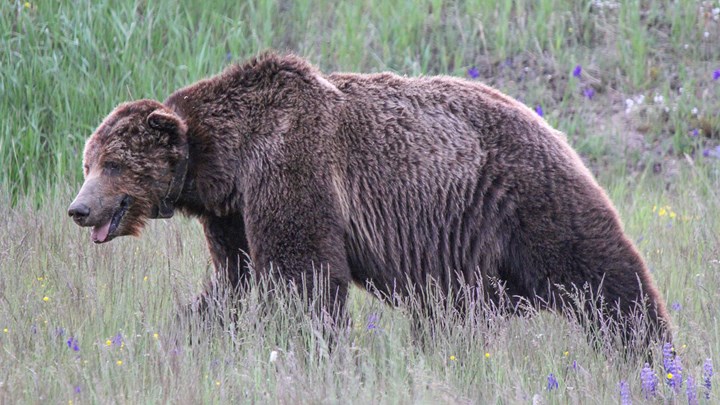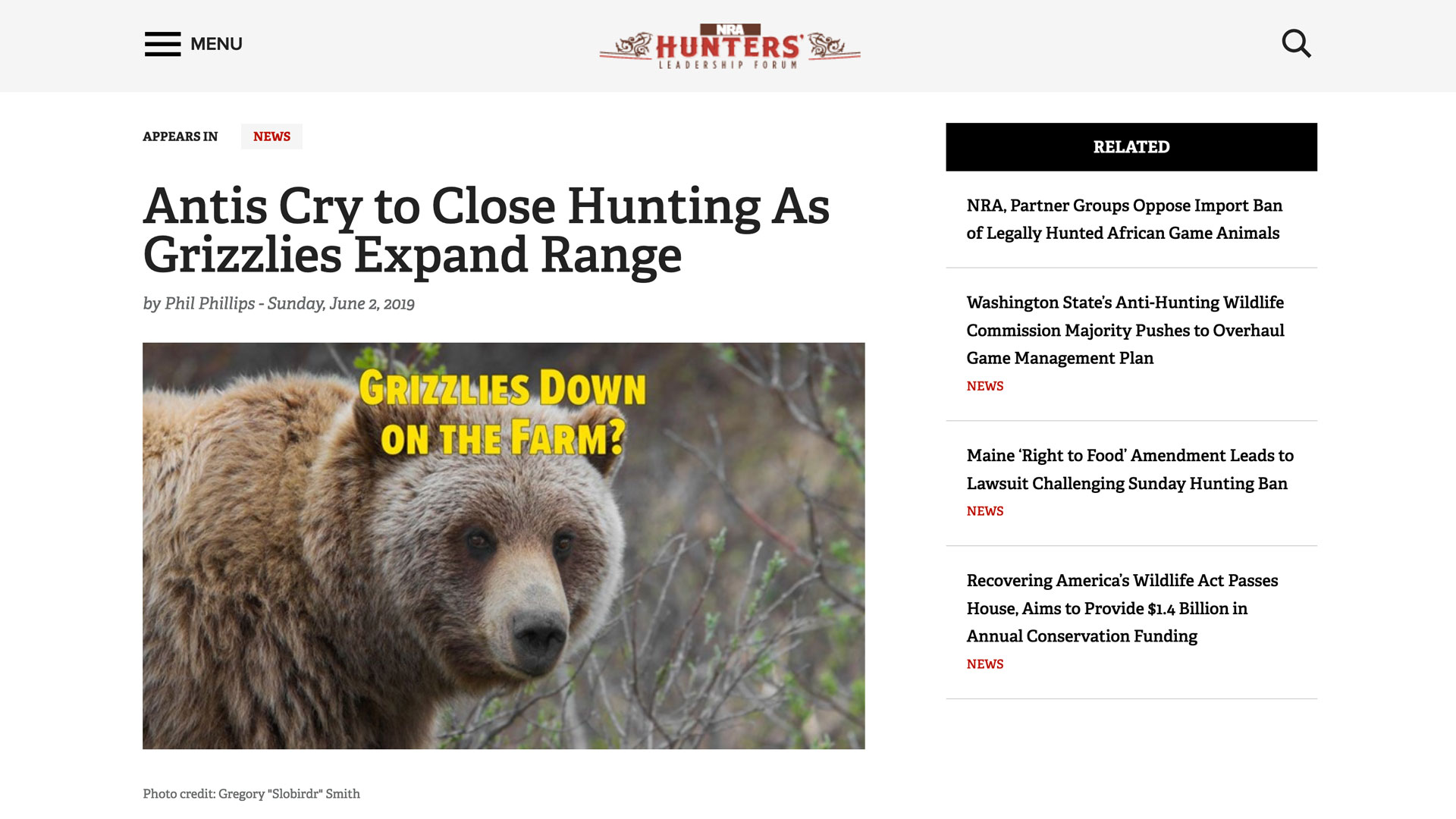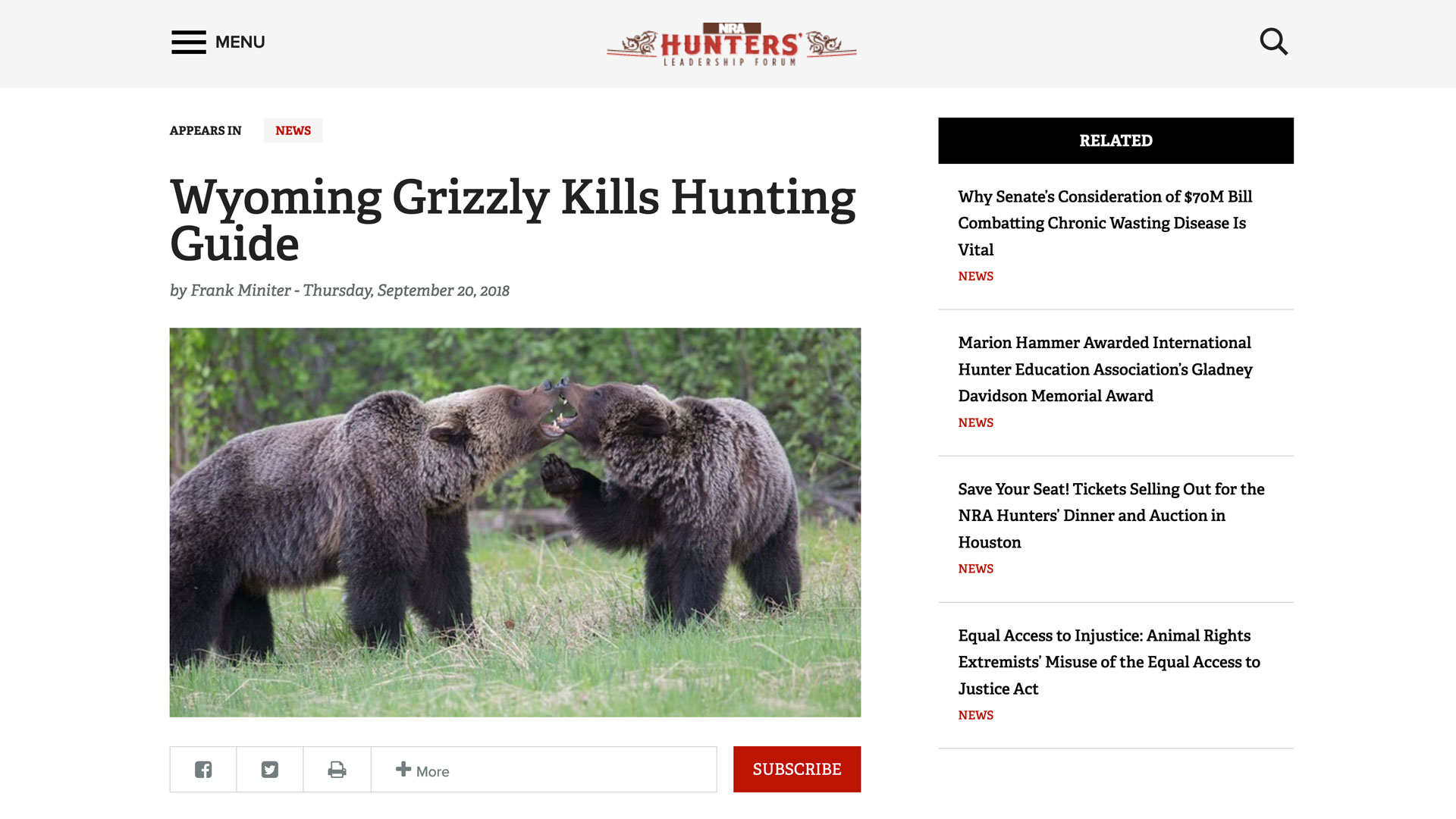
by Jim Zumbo - Wednesday, July 6, 2022

September 1, 2018, was slated to be a major American hunting and wildlife conservation victory. On that day, 22 hunters were set to legally hunt grizzly bears in Wyoming. Prior to the opener, nonresident and resident hunters alike had been preparing for their hunts in the northwest region of the state, some with outfitters, some on DIY hunts. I live outside Cody, in the middle of prime grizzly country, and heard the buzz around town. Many folks wondered if the hunt was really going to happen. It appeared the bears were destined to be federally protected under the Endangered Species Act (ESA) forever, but now a hunt was about to proceed.
In 1975, almost 50 years ago, grizzlies were placed on the endangered species list and hunting for the big bruins was terminated. After that decision, attorneys for animal rights groups as well as wildlife biologists and legislators argued the merits of delisting grizzlies. In 2017, after a frustrating, challenging period with endless litigation, U.S. Secretary of the Interior Ryan Zinke, a President Trump appointee, announced that the Yellowstone National Park (YNP) grizzly bear population had recovered and could be removed from the list. This meant the federal jurisdiction of the bears in the Greater Yellowstone Ecosystem (GYE) spanning Wyoming, Idaho and Montana was ended and grizzlies could then be managed by the three states’ wildlife agencies.
This news was met by widespread approval by those who were waiting for this decision for decades. In fact, it was somewhat of a shock. Soon afterward, a hunt was planned. Of the three GYE states, Wyoming offered 22 permits, Idaho issued one and Montana none.
But, to the delight of anti-hunters and their well-funded and well lawyered-up groups, as this NRA Hunters’ Leadership Forum website tracked, on Thurs., Aug. 30—two days before the hunt—Federal Judge Dana Christensen, an Obama appointee, ruled from his Missoula, Mont., bench that the hunt would be temporarily halted until he had more information. He said he would give a final ruling in two weeks. After the two-week period, he stated he needed two more weeks. Then, on Sept. 24, he proclaimed that the hunt be terminated and placed the bear back on the list. The hunters holding grizzly tags were denied the hunt by a liberal judge from New York City who believed he knew more about grizzlies than credible wildlife biologists from all three states who had been studying the bears for decades and had determined the bears had long since recovered. In fact, in the months following Christensen’s decision, GYE officials continued to report that the bears exceeded carrying capacity to the point they were encroaching on rural areas, expanding their range by 1,500 miles in a two-year period.

Of all the apex predators in the Lower 48, which includes wolves, grizzly bears, black bears and mountain lions, the grizzly is the most revered and feared. Many attacks, some fatal, have been attributed to the big bears of the Rocky Mountains. In grizzly country, warning signs everywhere alert the public to the presence of the bears, which have a reputation of being ferocious.
In 1804, when Lewis and Clark made their epic journey up the Missouri River over the Rockies and down to the Pacific Ocean, they had many encounters with grizzlies. Several of their experiences were recorded in their journal. Captain Meriwether Lewis wrote this in 1804: “These bear being so hard to die reather intimedates us all; I must confess that I do not like the gentlemen and had reather fight two Indians than one bear.”
Lewis added: “Six good hunters of the party fired at a Brown or Yellow Bear Several times before they killed him, & indeed he had like to have defeated the whole party, he pursued them Separately as they fired on him, and was near Catching Several of them, one he pursued into the river, this bear was large & fat would way about 500 wt… he pursued two of them seperately so close they were obliged to throw aside their guns and poucnes and throw themselves into the river altho’ the bank was nearly twenty feet perpendicular; so enraged was this animal that he plunged into the river only a few feet behind the second man he had compelled to take refuge in the water, when one of those who still remained on shore shot him through the head and finally killed him.”
The Lewis and Clark Expedition was successful in finding a route to the Pacific as ordered by President Thomas Jefferson, who initiated the project. Their journey helped ignite interest in exploring and colonizing the West by eager settlers. As the land was cleared and homesteads established, grizzly bears were shot and poisoned. The big bears were nuisances and were not tolerated. This war on grizzlies and other big predators continued throughout the West. In California, grizzly bears abounded to such an extent that the bear appears on the state flag, yet every single grizzly in that enormous state, much of it heavily timbered and remote, has been eradicated.
That same scenario played out throughout the West wherever grizzlies roamed with the exception of several regions in Montana, Wyoming and Idaho, thanks in part to Yellowstone and Glacier national parks where grizzlies were protected, as well as remote national forests surrounding those parks where bears found plenty of solace. There are six defined regions, the two biggest being the Northern Continental Divide Ecosystem (NCDE) in and around Glacier National Park with about 1,000 grizzlies, and the Greater Yellowstone Ecosystem (GYE) in and around Yellowstone Park with more than 600 bears. There are three other smaller regions in Montana and Idaho and a small population in Washington. It’s estimated that grizzlies now occupy 2 percent of the total land mass they once roamed.
Today grizzlies are still listed under the ESA due to Judge Christensen's decision, but governors of all three states have issued statements vowing to remove the bears from the list.
“The State is petitioning the U.S. Fish and Wildlife Service to delist the GYE grizzly bear population, following 46 years and more than $52 million in investment from Wyoming,” Gov. Mark Gordon said. “Grizzly bears, by all measures, have been fully recovered since 2003.”
It’s important to note that the $50-plus million bill is paid by Wyoming sportsmen as well as nonresidents who visit the state. It’s expensive to trap and relocate grizzlies, use aircraft to monitor their locations and pay personnel to oversee operations, as well as all the other logistical expenses. This isn’t fair. The bear is under the jurisdiction of the federal government, but the state gets stuck with the bill. And you and I, if you hunt or fish in Wyoming, are helping to pay that bill. I once asked a Wyoming wildlife official why the state must bear this responsibility. “Because no one else will do it,” he said. “The Feds are scattered thin. When we have an emergency with a bear that’s involved in a mauling or is killing livestock or has been acting in a dangerous manner around the public we have to respond.”
As an example, in 2021 Wyoming Game and Fish Department officials captured 45 individual grizzly bears in 49 capture events. (Four bears were captured twice.) Of the 49 individual bears captured, 32 were male grizzlies and 17 were females. Twenty-three bears were captured because they were killing livestock (primarily cattle); 17 because they had obtained food rewards (pet, livestock food, garbage, fruit trees) or were frequenting developed sites or human-populated areas unsuitable for grizzly bear occupancy. The rest of the captures were for other reasons, such as due to bears damaging cornfields, being extremely sick/emaciated, etc.
Of the 45 bears captured, 30 were removed, meaning that they were killed. Grizzlies are euthanized because they have a history of previous conflicts, a known history of close association with humans, and/or are deemed unsuitable for release into the wild, such as in the case of orphaned cubs, bears being in poor physical condition and/or human safety concerns. Interestingly, 43 percent of the capture events occurred in Park County, which is where I live, and 58 percent of the captured bears were relocated in Park County. This huge county includes much of the backcountry in Wyoming surrounding YNP.
Some bears must be removed under exceedingly dangerous circumstances. Several years ago, a Wyoming outfitter and his hunter were preparing to pack out an elk when they were charged by a sow grizzly and her large cub. The outfitter was killed, and the hunter barely escaped. The next day a half dozen wardens and wildlife officials cautiously approached the area and were attacked by the two bears. Guns were drawn and shouldered, and the bears were killed.

In addition, bears are killed in self-defense by hunters. Last year there were two grizzly incidents where Wyoming elk hunters were charged by enraged bears. In each case the hunters were able to kill the grizzlies without suffering serious injuries, though one hunter almost had his thumb ripped off. Similar reports regularly come out of other areas near YNP such as near West Yellowstone in Montana.
These grizzly bear encounters will continue to rise as bear populations continue to increase. Despite the pleas of the governors involved as well as bills introduced in Congress, the final decision falls on the shoulders of recently appointed Secretary of Interior (SOI) Deb Haaland, a Biden appointee and Native American whose agency includes the National Park Service, the Bureau of Land Management and the U.S. Fish and Wildlife Service. It’s the latter that has jurisdiction over threatened and endangered species.
When she was being vetted for the position, many legislators were concerned over her voting history when she was a member of the Senate and co-sponsored legislation in 2019 that would place permanent protections on grizzlies in the Lower 48. That concerned many legislators, especially those representing Wyoming, Idaho and Montana.
In a document released by the Senate Energy and Natural Resources Committee containing questions from members and Haaland’s answers, she wrote, “I am a Pueblo woman. We have been hunting wild game for centuries. My dad, my grandparents, my brother, they all hunt. In fact, I was fortunate to harvest an Oryx from the White Sands Missile Range. It fed my family for about a year. I absolutely understand and respect the sportsman and the anglers and their traditions. If confirmed, I look forward to working to ensure that all Americans have the kinds of opportunities that my family and I have had.”
When Sen. Steve Daines (R-MT) asked why she supported the 2019 legislation, she said she’d take another look at the issue and work with the states when it comes to bears.
Native Americans revere and respect large predators, especially the grizzly. Benjamin Nuvamsa, elder of the Hopi Bear Clan and director of the Global Indigenous Council, said, “He (the grizzly bear) is our uncle. He plays a central role in the traditions, ceremonies and the sovereignty of the native people. I do not know of a tribal nation that does not hold the grizzly in high regard.”
More than 200 tribes or tribal organizations have signed a treaty demanding protection for the grizzly bear. Many of them also have joined lawsuits to overturn the efforts of hunter-backed groups such as the National Rifle Association and Safari Club International to remove recovered grizzlies from the endangered species list.
Haaland’s ancestral connection to Native Americans must be seriously considered. But if she decides to delist the bear, you can be sure that animal rights extremists will seek and select a federal judge who is sympathetic to their cause. As we’ve seen in the past, even the SOI can be overruled.
Most recently, in February pro-wolf advocates were handed a huge victory by a federal judge in Northern California, who ruled that federal protection for gray wolves be restored across much of the United States despite ample science showing that the wolves have far exceeded their target numbers. Many of us scratch our heads and wonder how a judge halfway across the country can rule in such distant cases.
Much work needs to be done if the grizzly is to be delisted. It won’t be easy, especially since animal rights extremists continually attack the work of credible and professional wildlife biologists. It’s apparent that judges are easily swayed by the flawed “science” of extremist groups.
About the Author
Well-known in hunting circles, Jim Zumbo is an accomplished Western big-game hunter who also has hunted deer in all 50 states. Backed by two degrees in forestry and wildlife, he has had more than 2,000 articles published in outdoor publications, written 23 hunting books and conducted hunting seminars nationwide, including for NRA Hunter Services. In addition to serving as a full-time writer/editor for Outdoor Life magazine for 30 years, most of them as hunting editor, he was the host of “Jim Zumbo Outdoors” on the Outdoor Channel. A Benefactor Life member of the NRA, Zumbo has won numerous awards for his writing and remains active with conservation groups, including serving three terms on the Rocky Mountain Elk Foundation’s board of directors. His biography, Zumbo: Based on the True Story of Jim Zumbo and His Blog Heard Around the World, by K.J. Houtman, was released in November 2016.
E-mail your comments/questions about this site to:
[email protected]
Proudly supported by The NRA Foundation and Friends of NRA fundraising.
